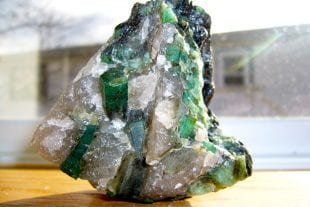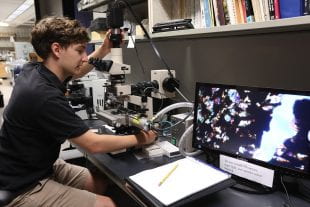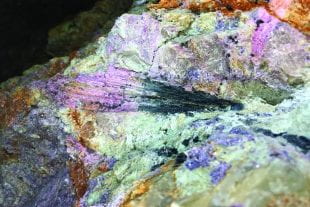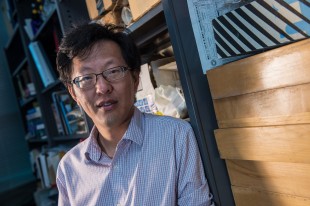Jeff Falk
713-348-6775
jfalk@rice.edu
Jade Boyd
713-348-6778
jadeboyd@rice.edu
Earth grows fine gems in minutes
Study: Crystals could grow up to a yard per day in some cooling magmas
HOUSTON — (Oct. 6, 2020) — Rome wasn’t built in a day, but some of Earth’s finest gemstones were, according to new research from Rice University.

Brazilian emeralds in a quartz-pegmatite matrix. (Photo courtesy of Madereugeneandrew/Wikimedia Commons)
Aquamarine, emerald, garnet, zircon and topaz are but a few of the crystalline minerals found mostly in pegmatites, veinlike formations that commonly contain both large crystals and hard-to-find elements like tantalum and niobium. Another common find is lithium, a vital component of electric car batteries.
“This is one step towards understanding how Earth concentrates lithium in certain places and minerals,” said Rice graduate student Patrick Phelps, co-author of a study published online in Nature Communications. “If we can understand the basics of pegmatite growth rates, it’s one step in the direction of understanding the whole picture of how and where they form.”
Pegmatites are formed when rising magma cools inside Earth, and they feature some of Earth’s largest crystals. South Dakota’s Etta mine, for example, features log-sized crystals of lithium-rich spodumene, including one 42 feet in length in weighing an estimated 37 tons. The research by Phelps, Rice’s Cin-Ty Lee and Southern California geologist Douglas Morton attempts to answer a question that has long vexed mineralogists: How can such large crystals be in pegmatites?
“In magmatic minerals, crystal size is traditionally linked to cooling time,” said Lee, Rice’s Harry Carothers Wiess Professor of Geology and chair of the Department of Earth, Environmental and Planetary Sciences at Rice. “The idea is that large crystals take time to grow.”
Magma that cools rapidly, like rock in erupted lavas, contains microscopic crystals, for example. But the same magma, if cooled over tens of thousands of years, might feature centimeter-sized crystals, Lee said.
“Pegmatites cool relatively quickly, sometimes in just a few years, and yet they feature some of the largest crystals on Earth,” he said. “The big question is really, ‘How can that be?'”
When Phelps began the research, his most immediate questions were about how to formulate a set of measurements that would allow him, Lee and Morton to answer the big question.
“It was more a question of, ‘Can we figure out how fast they actually grow?'” Phelps said. “Can we use trace elements — elements that don’t belong in quartz crystals — to figure out the growth rate?”
It took more than three years, a field trip to gather sample crystals from a pegmatite mine in Southern California, hundreds of lab measurements to precisely map the chemical composition of the samples and a deep dive into some 50-year-old materials science papers to create a mathematical model that could transform the chemical profiles into crystal growth rates.

Rice University graduate student Patrick Phelps used cathodoluminescence microscopy to measure the chemical composition of sample crystals. (Photo by Linda Welzenbach/Rice University)
“We examined crystals that were half an inch wide and over an inch long,” Phelps said. “We showed those grew in a matter of hours, and there is nothing to suggest the physics would be different in larger crystals that measure a meter or more in length. Based on what we found, larger crystals like that could grow in a matter of days.”
Pegmatites form where pieces of Earth’s crust are drawn down and recycled in the planet’s molten mantle. Any water that’s trapped in the crust becomes part of the melt, and as the melt rises and cools, it gives rise to many kinds of minerals. Each forms and precipitates out of the melt at a characteristic temperature and pressure. But the water remains, making up a progressively higher percentage of the cooling melt.
“Eventually, you get so much water left over that it becomes more of a water-dominated fluid than a melt-dominated fluid,” Phelps said. “The leftover elements in this watery mixture can now move around a lot faster. Chemical diffusion rates are much faster in fluids and the fluids tend to flow more quickly. So when a crystal starts forming, elements can get to it faster, which means it can grow faster.”
Crystals are ordered arrangement of atoms. They form when atoms naturally fall into that arranged pattern based on their chemical properties and energy levels. For example, in the mine where Phelps collected his quartz samples, many crystals had formed in what appeared to be cracks that had opened while the pegmatite was still forming.
“You see these pop up and go through the layers of pegmatite itself, almost like veins within veins,” Phelps said. “When those cracks opened, that lowered the pressure quickly. So the fluid rushed in, because everything’s expanding, and the pressure dropped dramatically. All of a sudden, all the elements in the melt are now confused. They don’t want to be in that physical state anymore, and they rapidly start coming together in crystals.”

Black tourmaline going to pink tourmaline within a quartz pegmatite at California’s Stewart Lithia mine. (Photo by Patrick Phelps/Rice University)
To decipher how quickly the sample crystals grew, Phelps used both cathodoluminescence microscopy and laser ablation with mass spectrometry to measure the precise amount of trace elements that had been incorporated into the crystal matrix at dozens of points during growth. From experimental work done by materials scientists in the mid-20th century, Phelps was able to decipher the growth rates from these profiles.
“There are three variables,” he said. “There’s the likelihood of things getting brought in. That’s the partition coefficient. There’s how fast the crystal is growing, the growth rate. And then there’s the diffusivity, so how quickly elemental nutrients are brought to the crystal.”
Phelps said the fast growth rates were quite a surprise.
“Pegmatites are pretty short-lived, so we knew they had to grow relatively fast,” he said. “But we were showing it was a few orders of magnitude faster than anyone had predicted.
“When I finally got one of these numbers, I remember going into Cin-Ty’s office, and saying, ‘Is this feasible? I don’t think this is right.'” Phelps recalled. “Because in my head, I was still kind of thinking about a thousand-year time scale. And these numbers were meaning days or hours.
“And Cin-Ty said, ‘Well, why not? Why can’t it be right?'” Phelps said. “Because we’d done the math and the physics. That part was sound. While we didn’t expect it to be that fast, we couldn’t come up with a reason why it wasn’t plausible.”
The research was supported by the National Science Foundation.
Morton, Lee’s lifelong friend and mentor, died Sept. 16. He was an adjunct professor emeritus of geology at the University of California, Riverside.
-30-
Links and resources:
The DOI of the Nature Communications paper is: 10.1038/s41467-020-18806-w
A copy of the paper is available at: https://doi.org/10.1038/s41467-020-18806-w
High-resolution IMAGES are available for download at:
https://commons.wikimedia.org/wiki/File:Emerald_in_a_quartz_and_pegmatite_matrix.JPG
CAPTION: Brazilian emeralds in a quartz-pegmatite matrix. (Photo courtesy of Madereugeneandrew/Wikimedia Commons)
https://news2.rice.edu/files/2020/10/1006_CRYSTAL-pp934adj-lg.jpg
CAPTION: Black tourmaline going to pink tourmaline within a quartz pegmatite at California’s Stewart Lithia mine. (Photo by Patrick Phelps/Rice University)
https://news2.rice.edu/files/2020/10/1006_CRYSTAL-lw151-lg.jpg
CAPTION: Rice University graduate student Patrick Phelps used cathodoluminescence microscopy to measure the chemical composition of sample crystals. (Photo by Linda Welzenbach/Rice University)
https://news2.rice.edu/files/2016/05/0516_LEE-CinTy-021-lg-28u6bae.jpg
CAPTION: Cin-Ty Lee (Photo by Jeff Fitlow/Rice University)
This release can be found online at news.rice.edu.
Follow Rice News and Media Relations via Twitter @RiceUNews.
Located on a 300-acre forested campus in Houston, Rice University is consistently ranked among the nation’s top 20 universities by U.S. News & World Report. Rice has highly respected schools of Architecture, Business, Continuing Studies, Engineering, Humanities, Music, Natural Sciences and Social Sciences and is home to the Baker Institute for Public Policy. With 3,978 undergraduates and 3,192 graduate students, Rice’s undergraduate student-to-faculty ratio is just under 6-to-1. Its residential college system builds close-knit communities and lifelong friendships, just one reason why Rice is ranked No. 1 for lots of race/class interaction and No. 1 for quality of life by the Princeton Review. Rice is also rated as a best value among private universities by Kiplinger’s Personal Finance.


